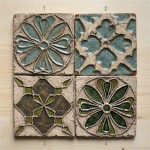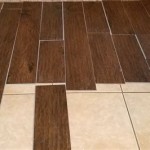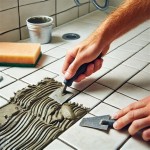How to Remove Silicone Sealant From Tiles Without Breaking Them
Silicone sealant is a common material used in bathrooms, kitchens, and other areas to create a waterproof barrier between tiles and fixtures. While effective at preventing water damage, silicone sealant can degrade over time, becoming discolored, cracked, or simply unsightly. Removing old or damaged silicone sealant is often necessary to maintain the appearance and integrity of tiled surfaces. However, this task requires careful execution to avoid damaging the tiles themselves. This article outlines methods and techniques for effectively removing silicone sealant from tiles without causing breakage or scratches.
The primary challenge in removing silicone sealant lies in its adhesive properties. Silicone bonds strongly to most surfaces, including tile, grout, and even porous materials. Attempts to simply peel or scrape the sealant off can easily result in chipped tiles, gouged grout lines, or surface scratches. Furthermore, using excessive force can compromise the structural integrity of the tiles, potentially leading to cracks or fractures. Therefore, a strategic approach is essential, combining softening techniques with careful and precise removal methods.
Before commencing the removal process, it is crucial to gather the necessary tools and materials. This includes a sharp utility knife or specialized sealant removal tool, a heat gun or hairdryer, a plastic scraper, mineral spirits or a dedicated silicone sealant remover, clean cloths, gloves, and eye protection. The utility knife should have a sharp, replaceable blade to ensure clean and precise cuts. The plastic scraper is preferred over metal scrapers to minimize the risk of scratching the tile surface. Mineral spirits or silicone sealant remover will help to dissolve the adhesive bond, making the sealant easier to remove. Gloves protect hands from chemicals and sharp tools, while eye protection prevents accidental splashes or debris from entering the eyes.
Softening the Silicone Sealant
The first step in removing silicone sealant is to soften it, thereby reducing its adhesion to the tile surface. Applying heat is a common and effective method for achieving this. A heat gun or hairdryer can be used to gently warm the sealant, making it more pliable and easier to cut or scrape away. The heat source should be held at a safe distance from the tile surface to prevent overheating and potential damage. It is important to move the heat source back and forth, avoiding prolonged exposure to a single spot. This will ensure even heating and minimize the risk of cracking or discoloration.
When using a heat gun, exercise extreme caution. Heat guns generate significantly higher temperatures than hairdryers and can easily damage tiles or surrounding materials if used improperly. Start with the lowest heat setting and gradually increase the temperature as needed. Regularly check the temperature of the tile surface by touching it briefly with a gloved hand. If the tile becomes too hot to touch comfortably, reduce the heat or move the heat source further away.
Alternatively, chemical softening agents can be used to weaken the bond between the silicone sealant and the tile surface. Mineral spirits, also known as white spirit, is a common solvent that can dissolve silicone. Apply mineral spirits liberally to the sealant and allow it to soak for several minutes. The longer the mineral spirits is allowed to penetrate the sealant, the easier it will be to remove. However, mineral spirits can also stain or damage some surfaces, so it is important to test it in an inconspicuous area first.
Specialized silicone sealant removers are also available. These products are specifically formulated to break down the chemical bonds in silicone, making it easier to remove. Follow the manufacturer's instructions carefully when using these products. Some sealant removers may require longer soaking times or specific application techniques. Always wear gloves and eye protection when handling chemical solvents, and ensure adequate ventilation in the work area.
Cutting and Scraping the Sealant
Once the silicone sealant has been sufficiently softened, the next step is to carefully cut and scrape it away from the tile surface. A sharp utility knife or specialized sealant removal tool is essential for this task. The goal is to cut along the edges of the sealant, separating it from the tile and grout lines. Hold the knife at a shallow angle to the tile surface and apply steady, even pressure. Avoid using excessive force, as this can cause the blade to slip and scratch the tile.
When using a utility knife, it is important to replace the blade frequently. A dull blade will require more force to cut through the sealant, increasing the risk of damaging the tile. A sharp blade will glide smoothly through the sealant, minimizing the risk of scratches or gouges. Dispose of used blades safely in a designated sharps container.
After cutting along the edges of the sealant, use a plastic scraper to gently lift and remove the remaining material. Start at one end of the sealant strip and work your way along, applying steady pressure to the scraper. Avoid using metal scrapers, as they can easily scratch the tile surface. If the sealant is still stubbornly adhering to the tile, apply more heat or chemical solvent and allow it to soak for a longer period of time. Patience is key to avoiding damage.
For tight corners or intricate areas, a small, flexible scraper can be used to remove the sealant without damaging the surrounding tiles. These scrapers are often made of plastic or rubber and are designed to conform to the shape of the surface. Apply gentle pressure and work slowly to avoid scratching the tile or grout.
Cleaning and Finishing
After removing the bulk of the silicone sealant, there may be some residual adhesive or residue remaining on the tile surface. This residue can be difficult to remove with scraping alone. The following cleaning methods should be followed to completely remove the remaining residue.
Mineral spirits or a dedicated silicone sealant remover can be used to dissolve the remaining residue. Apply the solvent to a clean cloth and gently rub the affected area. Avoid applying the solvent directly to the grout lines, as it can potentially stain or damage them. Allow the solvent to soak for a few minutes before wiping it away with a clean cloth.
If the residue is particularly stubborn, a mild abrasive cleaner can be used. However, it is important to choose a cleaner that is specifically formulated for use on tile and grout. Avoid using harsh abrasive cleaners, as they can scratch or dull the tile surface. Test the cleaner in an inconspicuous area first to ensure that it does not cause any discoloration or damage.
Baking soda paste can also be an effective cleaning agent for removing silicone residue. Mix baking soda with water to form a thick paste and apply it to the affected area. Allow the paste to sit for several minutes before scrubbing gently with a soft brush or cloth. Rinse the area thoroughly with clean water to remove any remaining baking soda residue.
Once the tile surface is clean and free of residue, inspect it carefully for any signs of damage, such as scratches or chips. If any damage is found, it may be necessary to repair or replace the affected tiles. Applying a fresh bead of silicone sealant will help to protect the tile surface from water damage and prevent future problems. Use a high-quality silicone sealant that is specifically designed for use in wet areas.
Following these steps provides a comprehensive guide on how to remove silicone sealant from tiles without causing damage. Softening the sealant with heat or chemical solvents, carefully cutting and scraping it away, and thoroughly cleaning the surface will ensure a successful outcome. Remember to exercise patience and caution throughout the process, and to use the appropriate tools and materials for the job.
How To Remove Silicone Sealant From Tile Glass Metal And Wood

How To Remove Silicone From Tiles A Step By Guide

How To Remove Silicone From Tiles A Step By Guide
How To Remove Silicone Sealant From Tile Glass Metal And Wood

How To Remove Silicone Sealant Daqiq Chimie Co

How To Remove Silicone Sealant From Tiles 100 Characters
How To Remove Silicone Sealant From Tile Glass Metal And Wood
How To Remove Silicone Sealant From Tile Glass Metal And Wood
How To Remove Silicone Sealant The Best Way Caulk

How To Remove Silicone Sealant Daqiq Chimie Co
Related Posts








